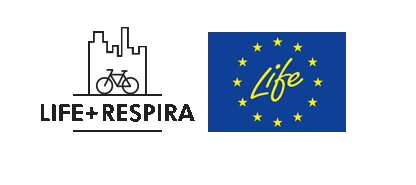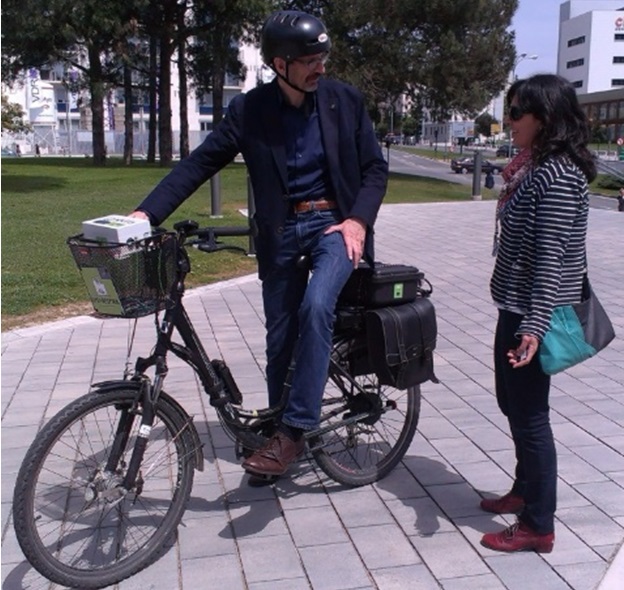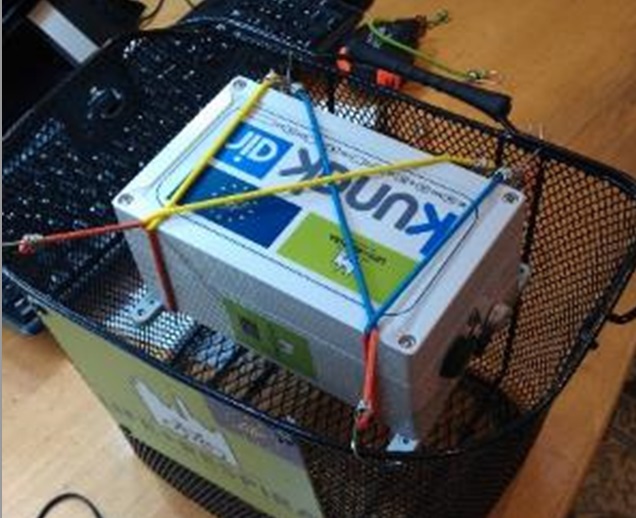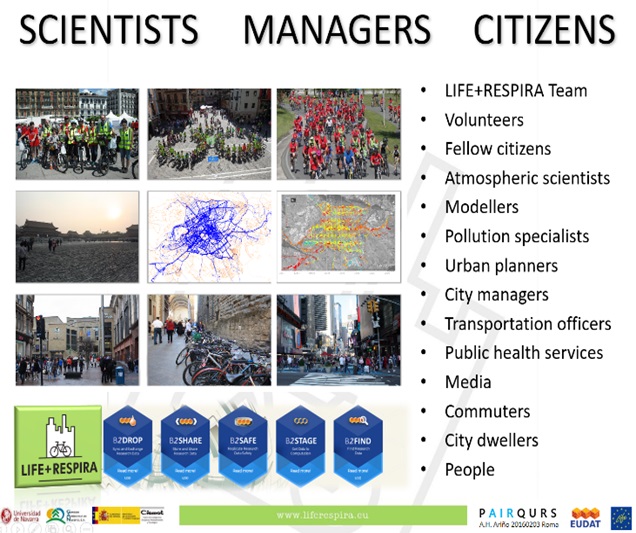
Arturo H. Ariño, from Universidad de Navarra in Pamplona, Spain, the main interface for the PAIRQURS – EUDAT data pilot, explains how EUDAT services and 150 “Citizen scientists” are helping to determine low-pollution paths for their daily cycle, motor, or pedestrian commute. |
 |
If you were to explain what PAIRQURS is in layman terms, how would you describe it?
PAIRQURS (public data access component of the bigger project LIFE+RESPIRA) consists of a network of 50 portable air pollution sensor suites that are carried by a team of volunteer cyclists during their daily commute throughout the city of Pamplona, Spain. By doing this they collect data records of atmospheric pollutants, other auxiliary data and GPS coordinates.
 |
Let’s get into more detail: how does this data collection work?
The suites include air-pollution detectors that actively suck up air to measure airborne particles as well as other sensors that work electrochemically, “perceiving” the contaminants and translating them into proportional voltages. The suites record the levels of selected atmospheric pollutants (namely CO, NOx, ozone, airborne particles), auxiliary data (T, HR) and GPS coordinates at 5 Hz and transmit processed packets via GPRS messaging to a central database. Data records are fed to a computational fluid dynamics (CFD) model built on the cityscape, and the model in turn enables an online route planner allowing commuters to select low-pollution paths for their cycle, motor, or pedestrian commutes.
|
 |
Contaminant gases and particles are recorded at very fine spatial and temporal resolution, and transmitted in near-real time for processing. A huge volume of data is being produced and, after heavy processing, serves to feed an air quality model allowing prediction of best routes for city dwellers. The pilot aims to ensure that citizens and researchers alike can fully access the pre-and post-processed data for any scientific, social, or policy purpose. |
What makes PAIRQURS so important?
Of course, there are other tools designed to calculate the air pollution, but they are often based on fixed points. Given the variety of our volunteers and the related data (e.g. routes, age, heartbeat etc.) our sensors manage to provide incredibly precise and comprehensive data. An example? The pixel size of the maps we produce thanks to the collected data have an error margin of just five meters. That is the precision of the data we provide. Moreover, our volunteers are ordinary people who therefore produce and collect data blindly, without being influenced and without being biased. That’s mainly why the quality of the data we collect is so high.
 |
How did you make use of EUDAT services and how did they change your project’s outcome?
EUDAT was crucial to the project’s success. We mainly used the B2DROP and B2SHARE services, as well as the user-friendly working space (B2TOGETHER). B2DROP is our main repository as its ease of use allows us to quickly drop our huge quantity of data (about 12 million records, each containing dozens of readings). Just as efficiently, B2SHARE will help us to circulate our data and release them for public use. Finally, the sustainability of EUDAT is what really thrills us now as it allows us to have an enormous collection of relevant data over an extended span of time, giving us the possibility to produce even more detailed analysis and evaluation on the evolution of air pollution over time. EUDAT has enormously helped reduced the costs.
|
Who and what makes PAIRQURS possible?
First of all, our 150 volunteers, all between 14 and 80 years old, who are normal citizens living in Pamplona, as well as our science team of 16, many of whom are also riding daily.
Why did you choose Pamplona?
Well, most of the science team live and work in Pamplona, which also happens to be quite an average European city in terms of number of inhabitants and size. Therefore, it was the right place to start collecting data. We were incredibly lucky to find such a warm response from our volunteers.
You said “start”: do you plan to expand this project to other cities and projects?
As far as the city of Pamplona is concerned, these sensors will be used after the project, as long as they last (they are designed to last at least 3 years, but this lifespan may vary also depending on how often the suites are used and recharged). Other European cities have already asked to join this network (such as Madrid). At this stage, our data (which we are still collecting as we speak), needs to be evaluated by the scientific community and put into context. As you know, raw data can be erroneously understood and the wrong considerations could be made. However, after having set a scale to read this data, the final aim is to make data public and free to all citizens. We are progressing on the extension of our project: for instance, PAIRQURS has started co-working on school programmes, where we teach school kids about the importance of data collection and showcase our sensors (and even lend them for trial). But we imagine a short-term future where the sensors will not only be on bicycles, but also on cars, public transports, windows and many other places.
About Arturo H. Ariño:Arturo trained as marine zoologist and is now professor of Ecology and Bioinformatics at the University of Navarra (UNED), where he heads the Department of Environmental Biology. He is also the Director of the Museum of Sciences within the University. His research interests span from theoretical ecology to environmental science, and his main focus is biodiversity patterns at global scale using big data approaches for data quality evaluation. He served as vice-chair of the Science Committee of the Global Biodiversity Information Facility (GBIF) and is also involved in RDA working groups.
About PAIRQURS:PAIRQURS (or Public access to fine-grained city air quality data from roving sensors) is the public data access component of the project LIFE+RESPIRA (www.liferespira.eu). Click here to find more information on the EUDAT – PAIRQURS pilot.
